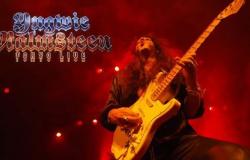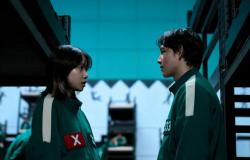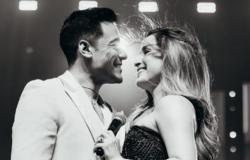central artist of Argentine contemporary art, Luis Felipe “Yuyo” Noah, who died exactly one month ago, left a very valuable legacy that can be seen in Buenos Aires, San Juan and Misiones. His production, his work and his theoretical reflections – in which the concept of chaos is key: it is not disorder, but the true order of things in a permanent state of mobility – are unavoidable chapters of the history of local art. Noah created a unique cosmogony.
In the sixties the new figuration joined with Ernesto Deira, Romulo Macció and Jorge de la Vega. It should be clarified that Noah the term “new figuration” never liked. The group was the protagonist of a time break: he explored new artistic languages, sought a way overcoming the opposition between figuration and abstraction: local painting revolutionized.
In it National Museum of Fine Arts It can be seen Introduction to Hopewhich was presented at the National Contest of the Torcuato Di Tella Institute, in 1963, along with other works of its authorship, and won the National Painting Prize. In this piece, Noah bankrupt the unit of the painting including complementary racks to the central frame. Later it copes the term “chaos.” “In 1964 he traveled to New York for the first time – writes Mercedes Casanegra on this piece.. Full with him.
Also in the largest museum in Argentina it is exposed The anarchy of the year XX”(1961), one of the thirteen pieces that make up the federal series, which Noah exposed in the Bonino Gallery of Buenos Aires during May 1961.“ (…) After having also received the examples of the painting arising after World War II –action painting And informalism – and without denying the successive avant -garde (on the contrary, loving them), I felt nourished equally as figurative and abstract experiences, “said the painter about this stage. And he added:” Argentine history, in this sense it was a source of inspiration. “
In Amalita collectionit is possible to see Jupiter Tonte1960 work Mixta technique on screen, and Errors and omissions reports”, 1997. In macro, hang Elements of rebellionof 1986. It is a landscape that presents an almost geometric visual construction. Noah divides the image from unstructured diagonal lines, with which he builds different color planes. It contains references to nature, such as the blue and green blue of the earth, both dyed by the oranges of the sun. Thus forms an almost three -dimensional painting in an apparent chaos. The gamelarge -format work that the artist painted two years before, in 1984, when he had to leave Argentina and, that alludes to the period of the military dictatorship in our country, is exhibited in the permanent collection of the Franklin Rawson Museum, of San Juan.
In Klemm Foundation, in the exhibition An appointment with popwith curatorship by Rodrigo Alonso, it is included Eroticon. In the Campo Museum, Cañuelas is exposed Symphonythat the artist began at the end of the 1980s and resumed during the pandemic, in 2020. In this piece, Noah incorporates the color vibratory line as aesthetic resource – it is part of his identity visual language. Add the spiral of chaos that condenses different aesthetics to propose a new one.
In the interpretation center of the Guaraní San Ignacio Miní team, in missions, you can see Misiones: Nature and Historya work of 1987, where the exuberance of the color hypnotizes. The work consists of four large pieces (each of more than two meters high by almost two from side) painted with acrylics, inks, charcoal and cakes. It synthesizes the history of the region at four different moments: the natural state, the conquest, the Jesuit state and, finally, expulsion and destruction.
It is also exhibited at the Cañuelas Campo Museum Complex hopemade by the artist in 2022, with polyuretanic paint, polyester resin, wood, bronze, copper and stainless steel, almost 5 meters high. Noah was inspired by a dead tree, carbonized by a ray he saw in this outdoor museum. He attracted the tree cortex, in which he noticed a plot similar to that of his works. The first step was to extract the tree, which moved to a sawmill. And after being intervened by the artist, they took him again to the field.
“I opted to relate directly to nature through a burned trunk that had to be extracted from the earth and clean up from impurities, which meant his investment: the roots in the place of the branches of the tree. This seemed magnificent in the sense that I always are interested in finding the image by the right and the reverse – said the artist on this piece. Partial copies of some of its branches in bronze, I was putting together this work with the spirit of a title that I place as a stimulus: Complex hope”.
In Muntref, Immigrant Exhotel, capture Among the timesa piece that the artist made with the stained glass technique, little used in contemporaneity, when in 2023, from Muntref, they invited him to make a stained glass intervention on the iron and glass bridge that unites the body of elevators with the building of the old immigrants hotel, where the contemporary art center and immigration museum works.
A few days after visiting the space, Noah presented a project. The realization was in two stages: the first, involved the stained glass window, installed in November 2023, and the second (which looks at the river) was installed in mid -2024. Middle, ”says Diana Wechsler, artistic director of Muntref and Bienalsur. Among the glass fragments, there are two curiosities: Noah included some glass of the old windows of the Immigrant Hotel; Others are fragments of mirrors. “These offer an interesting symbolic resolution by allowing the nearby river to be reflected in the city and vice versa,” says Wechsler.






